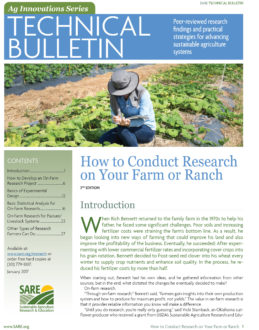- Have good, reliable scales for livestock, feed, forage, etc. Check them often with something of known weight.
- Use several pens or paddocks of the same size for side-by-side, pen-to-pen comparisons.
- Use two or more feed storage bins for feeding trials, if you are using different diets.
- Allot or assign animals to the treatments carefully. The pens need to be as much alike as possible, with equal numbers of heifers and steers grouped together in one pen, or both larger and smaller animals included in each pen.
- Weigh animals. Cattle, especially, can have varying amounts of feed and water, or fill, in their digestive tracts. The rumen in a mature cow’s stomach can hold 42 gallons, or 350 pounds. Weigh the cattle in the morning before they are fed, under the same conditions. If the cattle are on pasture, they should be penned in a dry lot the night before weighing.
- Animals unexpectedly die during experiments. Record the date, cause of death and weight of the dead animal as soon as it is discovered. These records are helpful in accounting for the feed and gain of the dead animal.
- Use a team approach. Feed suppliers, veterinarians, Extension or university staff, and electric fence suppliers make great team members. Link with other livestock producers with similar interests.
- Think about what you are measuring. Animal growth or weight gain, feed intake, days on feed and milk production are common measurable livestock outputs.
- Write it down! Keeping notes about your observations may be as important as actual data.
- Start small and keep it simple. Do not design elaborate comparisons, particularly at first.
- Use available technology. All-terrain vehicles, cellphones, ear tags, electric fencing, freeze branding and plastic water pipe make many studies possible.
How to Conduct Research on Your Farm or Ranch
Tips for On-Farm Livestock Research
SARE Outreach
| 2017 | 32 pages
PDF (1.7 MB)
or call (301) 779-1007 to order.
